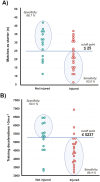Non-contact injury incidence in professional women's football depends on the starting status of the player
- PMID: 40656988
- PMCID: PMC12244399
- DOI: 10.5114/biolsport.2025.145916
Non-contact injury incidence in professional women's football depends on the starting status of the player
Abstract
This study aimed to determine differences in the incidence of non-contact injury in professional women football players with different starting statuses. Data from 37 women (age: 28.5 ± 3.9 years; body mass: 62.3 ± 5.2 kg; height: 169.8 ± 4.7 cm) from a professional football team (Professional Women's Football League from Spain) were prospectively collected during two consecutive seasons. Players were classified according to their match starting status as starters (players with > 70% of matches in the starting lineup; n = 20) and non-starters (n = 17). External load parameters were collected using GPS in all training sessions and matches. Non-contact injuries were diagnosed, classified, and recorded by the medical staff following the IOC consensus. Statistics included comparisons of starters vs. non-starters and linear regression and diagnostic analyses of injured vs. non-injured players. Non-starters accumulated less match load over the season but had two-fold non-contact injury incidence and three-fold muscular injury incidence during matches than starters, despite being exposed to a similar training load. The larger the number of matches played as a starter, the fewer injuries (non-contact: R2 = 0.27, p = 0.01; muscular: R2 = 0.11, p = 0.04). Diagnostic analyses identified clinical thresholds for insufficient match and training loads during the season accounting for higher injury risk. Less than 5,237 decelerations and 25 matches as a starter per season during training was the best indicator to discriminate players with less likelihood of non-contact injury. Football players with less match exposure from a women's professional squad may be more prone to injury due to under-exposure to the demands of the game.
Keywords: Elite athlete; Load monitoring; Performance; Soccer; Team sports; Tracking.
Copyright © Institute of Sport – National Research Instutite.
Conflict of interest statement
The authors declare no conflicts of interest.
Figures



Similar articles
-
Application of Global Positioning System and Microsensor Technology in Competitive Rugby League Match-Play: A Systematic Review and Meta-analysis.Sports Med. 2016 Apr;46(4):559-88. doi: 10.1007/s40279-015-0440-6. Sports Med. 2016. PMID: 26714810
-
Association Between the COL5A1 rs12722 Genotype and the Prevalence of Anterior Cruciate Ligament Rupture in Professional Football Players.Genes (Basel). 2025 May 28;16(6):649. doi: 10.3390/genes16060649. Genes (Basel). 2025. PMID: 40565541 Free PMC article.
-
Growth-related sports injuries among young male professional football players in the Netherlands: a prospective cohort study concerning injury incidence, severity and burden.Sci Med Footb. 2025 Feb;9(1):26-37. doi: 10.1080/24733938.2023.2261399. Epub 2023 Sep 29. Sci Med Footb. 2025. PMID: 37740902
-
The Football Association Injury and Illness Surveillance Study: The Incidence, Burden, and Severity of Injuries in English Women's Domestic Football-A 5-Year Prospective Cohort Study.Scand J Med Sci Sports. 2025 Jul;35(7):e70094. doi: 10.1111/sms.70094. Scand J Med Sci Sports. 2025. PMID: 40576331 Free PMC article.
-
Injury incidence rates in women's football: a systematic review and meta-analysis of prospective injury surveillance studies.Br J Sports Med. 2023 Apr;57(8):471-480. doi: 10.1136/bjsports-2021-105177. Epub 2022 Oct 13. Br J Sports Med. 2023. PMID: 36229168
References
-
- FIFA . Women’s Football: Member Associations Survey Report 2023 [Internet]. 2023. Available from: https://digitalhub.fifa.com/m/28ed34bd888832a8/original/FIFA-Women-s-Foo...
-
- Bradley PS, Scott D. Physical analysis of the FIFA women’s world cup France 2019TM [Internet]. FIFA. 2020. Available from: https://digitalhub.fifa.com/m/4f40a98140d305e2/original/zijqly4oednqa5gf...
-
- Martínez-Lagunas V, Niessen M, Hartmann U. Women’s football: Player characteristics and demands of the game. J Sport Heal Sci. 2014; 3(4):258–72.
-
- Datson N, Hulton A, Andersson H, Lewis T, Weston M, Drust B, Gregson W. Applied physiology of female soccer: an update. Sports Med. 2014; 44(9):1225–40. - PubMed
LinkOut - more resources
Full Text Sources
